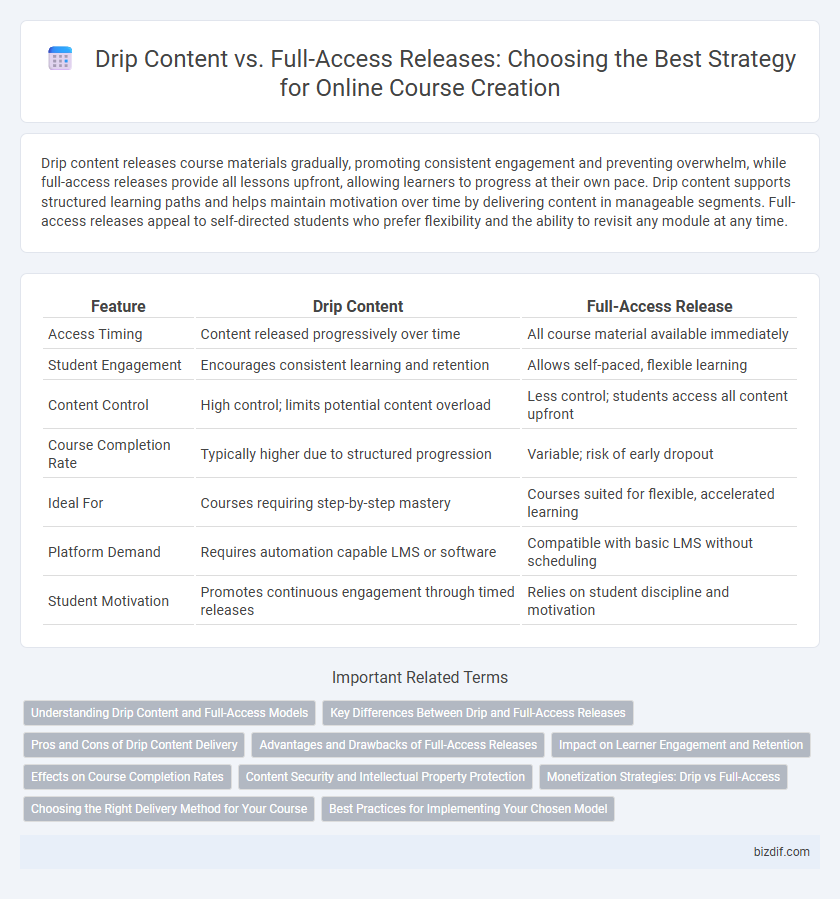Drip content releases course materials gradually, promoting consistent engagement and preventing overwhelm, while full-access releases provide all lessons upfront, allowing learners to progress at their own pace. Drip content supports structured learning paths and helps maintain motivation over time by delivering content in manageable segments. Full-access releases appeal to self-directed students who prefer flexibility and the ability to revisit any module at any time.
Table of Comparison
| Feature | Drip Content | Full-Access Release |
|---|---|---|
| Access Timing | Content released progressively over time | All course material available immediately |
| Student Engagement | Encourages consistent learning and retention | Allows self-paced, flexible learning |
| Content Control | High control; limits potential content overload | Less control; students access all content upfront |
| Course Completion Rate | Typically higher due to structured progression | Variable; risk of early dropout |
| Ideal For | Courses requiring step-by-step mastery | Courses suited for flexible, accelerated learning |
| Platform Demand | Requires automation capable LMS or software | Compatible with basic LMS without scheduling |
| Student Motivation | Promotes continuous engagement through timed releases | Relies on student discipline and motivation |
Understanding Drip Content and Full-Access Models
Drip content delivers course materials incrementally over time, enhancing learner retention by pacing information and reducing overwhelm. Full-access releases provide instant availability of all course modules, promoting self-paced learning and flexibility. Choosing between drip content and full-access models depends on desired learner engagement and course structure goals.
Key Differences Between Drip and Full-Access Releases
Drip content releases deliver course material incrementally over a set schedule, promoting consistent learner engagement and preventing content overload. Full-access releases provide students immediate entry to all materials, allowing self-paced learning and flexibility. Key differences include pacing control, learner autonomy, and content accessibility, which influence course completion rates and user experience.
Pros and Cons of Drip Content Delivery
Drip content delivery in online course creation offers paced learning by releasing materials incrementally, which can improve student retention and reduce overwhelm. This method promotes consistent engagement and supports mastery of topics before advancing, but may frustrate learners who prefer self-paced, immediate access to all content. While drip content enhances course structure and accountability, it can limit flexibility and speed for motivated students seeking accelerated progress.
Advantages and Drawbacks of Full-Access Releases
Full-access releases enable learners to access all course materials immediately, fostering self-paced learning and catering to diverse schedules. This approach enhances user satisfaction by allowing instant knowledge application and continuous motivation without waiting for content unlocks. However, it may overwhelm some students, reduce anticipation-driven engagement, and increase the risk of content piracy or reduced course longevity.
Impact on Learner Engagement and Retention
Drip content delivery schedules course materials in gradual segments, fostering consistent learner engagement and preventing overwhelm by maintaining a steady learning pace. Full-access releases offer instant availability of all materials, encouraging self-paced study that can benefit motivated learners but risks early drop-off due to lack of structured progression. Data reveals that drip content increases retention rates by up to 30% through sustained interaction, while full-access models suit advanced students who prefer flexibility over guided schedules.
Effects on Course Completion Rates
Drip content delivery, by pacing material over time, significantly improves course completion rates by reducing learner overwhelm and encouraging consistent engagement. Full-access releases provide flexibility but can lead to lower completion rates due to procrastination and content overload. Studies show that drip content increases course completion by up to 35%, highlighting its effectiveness in maintaining learner motivation.
Content Security and Intellectual Property Protection
Drip content releases enhance content security by limiting access to course materials over time, reducing the risk of unauthorized sharing and piracy. Full-access releases may increase vulnerability to intellectual property theft, as learners can download or distribute all materials immediately. Implementing drip content systems supports better control over intellectual property protection by controlling the flow and timing of content exposure.
Monetization Strategies: Drip vs Full-Access
Drip content releases optimize monetization by encouraging consistent engagement and reducing content overwhelm, increasing student retention and lifetime value. Full-access releases boost immediate revenue by offering instant gratification, appealing to buyers who prefer comprehensive access upfront. Choosing between drip and full-access impacts cash flow timing, customer satisfaction, and upsell opportunities in online course business models.
Choosing the Right Delivery Method for Your Course
Drip content delivery method releases course material gradually, enhancing learner retention and motivation by pacing information over time, while full-access releases provide immediate availability of all content, catering to self-paced learners seeking flexibility. Choosing the right delivery method depends on factors such as course complexity, learner engagement goals, and instructional design. Implementing analytics to track student progress can inform whether staggered content or full access improves completion rates and satisfaction.
Best Practices for Implementing Your Chosen Model
Drip content releases enhance learner engagement by delivering course material incrementally, allowing for better knowledge retention and preventing overwhelm. Full-access releases provide students with immediate access to all content, supporting self-paced learning and catering to diverse schedules. Best practices for drip models include consistent scheduling and clear communication, while full-access implementations benefit from comprehensive onboarding and progress tracking tools.
Drip content vs Full-access releases Infographic

 bizdif.com
bizdif.com